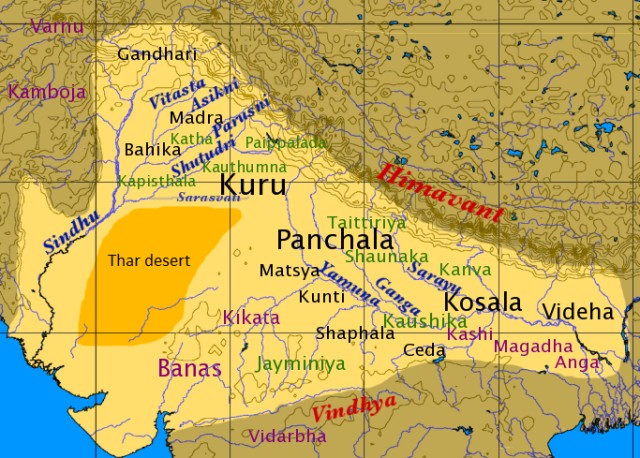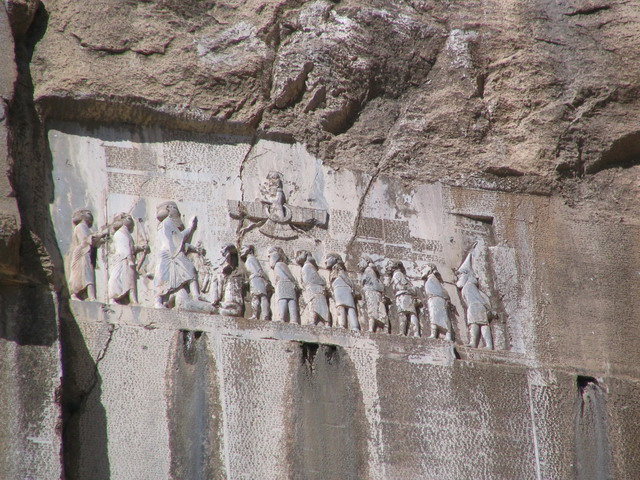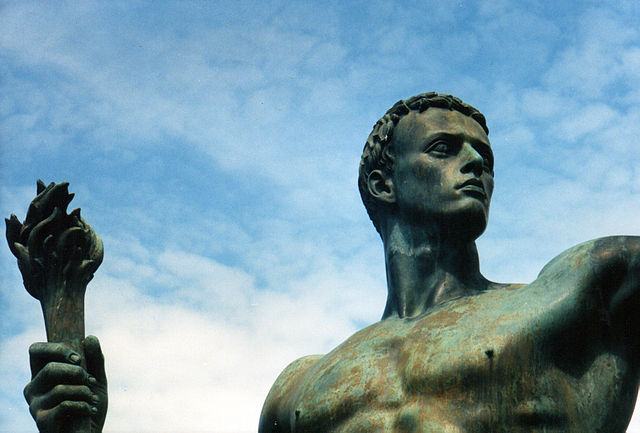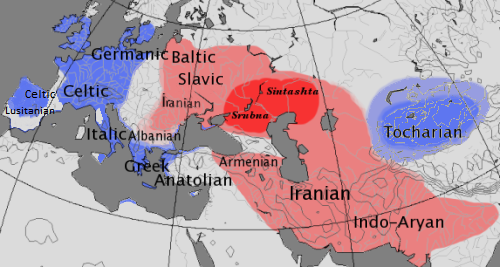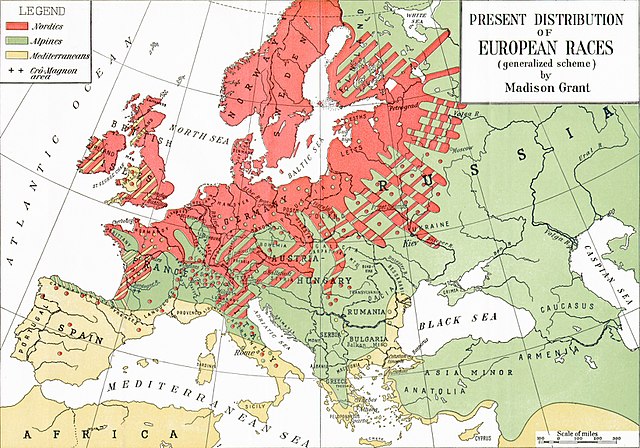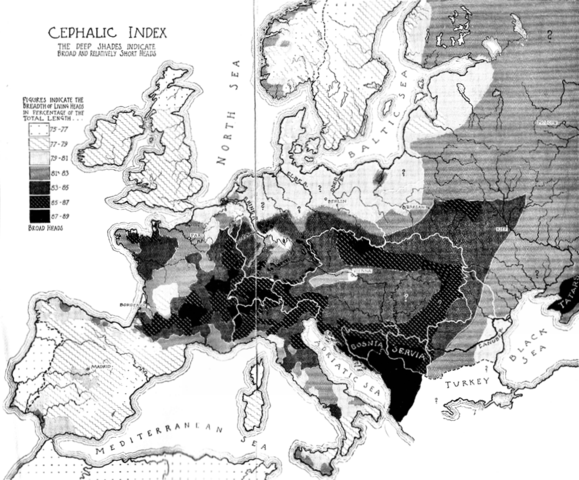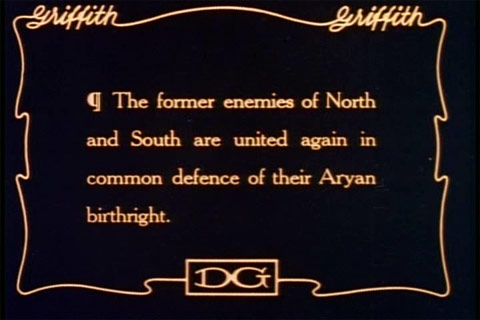
| ARYAN
Aryavart, which meant "the home of Aryas Aryan is, originally, a term used as a self-designation by Indo-Iranian peoples in ancient times, in contrast to "non-Indo-Aryan" or "non-Iranian" peoples. In Ancient India, the term a´rya- was used by the Indo-Aryan speakers of the Vedic period as a religious label for themselves, as well as the geographic region known as Aryavart, where the Indo-Aryan culture emerged.
Similarly,
ancient Iranian peoples used the term airya- as an ethnic label
for themselves and in reference to their mythical homeland, Airyanem
Vaejah, in the Avesta scriptures. The root also forms the etymological
source of the place names Iran and Alania.
Etymology
:
Indo-Iranian :
One
of the earliest epigraphically attested reference to the word arya
occurs in the 6th-century BC Behistun inscription, which describes
itself as having been composed "in arya [language or script]"
(§ 70). As is also the case for all other Old Iranian language
usage, the arya of the inscription does not signify anything but
"Iranian".
In early Vedic literature, the term Aryavart (abode of the Aryans) was the name given to northern India, where the Indo-Aryan culture was based. The Manusmriti (2.22) gives the name Aryavart to "the tract between the Himalaya and the Vindhya ranges, from the Eastern (Bay of Bengal) to the Western Sea (Arabian Sea)".
Initially the term was used as a national name to designate those who worshipped the Vedic deities (especially Indra) and followed Vedic culture (e.g. performance of sacrifice, Yagna).
The Avestan term airya ('venerable') and the Old Persian ariya are also derivates of *aryo-, and were likewise used as self-designations. In Iranian languages, the original self-identifier lives on in ethnic names like "Alans" and "Iron". Similarly, the name of Iran is the Persian word for the land or place of the Aryans.
Proto-Indo-Iranian
:
• Indo-Iranian: *arya-,
Proto-Indo-European :
• The Hittite prefix ara- meaning member of one's own group, peer, companion and friend;
The word *h2er(y)ós itself is believed to have come from the root *h2er- meaning "put together". The original meaning in Proto-Indo-European had a clear emphasis on the "in-group status" as distinguished from that of outsiders, particularly those captured and incorporated into the group as slaves. While in Anatolia, the base word has come to emphasize personal relationship, in Indo-Iranian the word has taken a more ethnic meaning.
A review of numerous other ideas, and the various problems with each is given by Oswald Szemerényi. According to Szemerényi it is probably a Near-Eastern loanword from the Ugaritic ary, kinsmen.
Modern
usage :
•
Indo-Aryan peoples
:
Arno Breker's sculpture Die Partei (The Party), demonstrating the ideal characteristics of a Nordic Aryan During the 19th century it was proposed that "Aryan" was also the self-designation of the Proto-Indo-Europeans. Based on speculations that the Proto-Indo-European homeland was located in northern Europe, a 19th-century hypothesis which is now abandoned, the word developed a racialist meaning.
The Nazis used the word "Arier" meaning "Aryan" to describe people in a racial sense. The Nazi official Alfred Rosenberg believed that the Nordic race was descended from Proto-Aryans, who he believed had prehistorically dwelt on the North German Plain and who had ultimately originated from the lost continent of Atlantis. According to Nazi racial theory, the term "Aryan" described the Germanic peoples. However, a satisfactory definition of "Aryan" remained problematic during Nazi Germany.
The Nazis considered the purest Aryans to be those that belonged to the "Nordic race" physical ideal, known as the "master race" during Nazi Germany. Although the physical ideal of the Nazi racial theorists was typically the tall, fair-haired and light-eyed Nordic individual, such theorists accepted the fact that a considerable variety of hair and eye colour existed within the racial categories they recognised. For example, Adolf Hitler and many Nazi officials had dark hair and were still considered members of the Aryan race under Nazi racial doctrine, because the determination of an individual's racial type depended on a preponderance of many characteristics in an individual rather than on just one defining feature.
In September 1935, the Nazis passed the Nuremberg Laws. All Aryan Reich citizens were required to prove their Aryan ancestry, one way was to obtain an Ahnenpass by providing proof through baptismal certificates that all four grandparents were of Aryan descent.
In December 1935, the Nazis founded Lebensborn to counteract the falling Aryan birth rates in Germany, and to promote Nazi eugenics.
Name :
Aryan (name), including derivatives such as Arya, Ariyan, Aria, and Aaryan, continues to be used as given names and surnames in South Asia and Iran. There has also been a rise in names associated with Aryan in the West, which has been popularized due to pop culture. According to the U.S. Social Security Administration in 2012, "Arya" was the fastest-rising girl's name in popularity in the U.S., jumping from 711th to 413th position. The name entered the top 200 most commonly used names for baby girls born in England and Wales in 2017. Although this could also be attributed to an increase of South Asian and Iranian diasporas immigrating into the West.
Usage
and adaptation in other languages :
Various Indian religions, chiefly Hinduism, Jainism and Buddhism, use the term arya as an epithet of honour; a similar usage is found in the name of Arya Samaj.
The usage of self-designation Arya was not limited to north India. The south indian emperor of Chola kingdom Rajendra Chola I gives himself the title Aryaputra (son of arya).
In Ramayan and Mahabharat, arya is used as an honorific for many characters including Hanuman.
Indo-European language throughout Europe and the Middle East
In Avesta and Persian literature :
The Avesta clearly uses airya/airyan as an ethnic name (Vd. 1; Yt. 13.143-44, etc.), where it appears in expressions such as airyafi; dain´havo "Iranian lands, peoples", airyo.šayanem "land inhabited by Iranians", and airyanem vaejo vanhuyafi; daityayafi; "Iranian stretch of the good Daitya", the river Oxus, the modern Amu Darya.
Old Persian sources also use this term for Iranians. Old Persian which is a testament to the antiquity of the Persian language and which is related to most of the languages/dialects spoken in Iran including modern Persian, the Kurdish languages, Balochi, and Gilaki makes it clear that Iranians referred to themselves as Arya.
The term "Airya/Airyan" appears in the royal Old Persian inscriptions in three different contexts :
1.
As the name of the language of the Old Persian version of the inscription
of Darius I in Behistun
The Old Persian and Avestan evidence is confirmed by the Greek sources. Herodotus in his Histories remarks about the Iranian Medes that: "These Medes were called anciently by all people Arians; " (7.62). In Armenian sources, the Parthians, Medes and Persians are collectively referred to as Aryans. Eudemus of Rhodes apud Damascius (Dubitationes et solutiones in Platonis Parmenidem 125 bis) refers to "the Magi and all those of Iranian (áreion) lineage"; Diodorus Siculus (1.94.2) considers Zoroaster (Zathraustes) as one of the Arianoi.
Strabo,
in his Geography, mentions the unity of Medes, Persians, Bactrians
and Sogdians :
—
Geography, 15.8
The Bactrian language (a Middle Iranian language) inscription of Kanishk the Great, the founder of the Kushan Empire at Rabatak, which was discovered in 1993 in an unexcavated site in the Afghanistan province of Baghlan, clearly refers to this Eastern Iranian language as Arya.
In the post-Islamic era one can still see a clear usage of the term Aryan (Iran) in the work of the 10th-century historian Hamzah al-Isfahani. In his famous book "The History of Prophets and Kings", al-Isfahani writes, "Aryan which is also called Pars is in the middle of these countries and these six countries surround it because the South East is in the hands China, the North of the Turks, the middle South is India, the middle North is Rome, and the South West and the North West is the Sudan and Berber lands". All this evidence shows that the name arya "Iranian" was a collective definition, denoting peoples (Geiger, pp. 167 f.; Schmitt, 1978, p. 31) who were aware of belonging to the one ethnic stock, speaking a common language, and having a religious tradition that centered on the cult of Ahura Mazda.
In Iranian languages, the original self-identifier lives on in ethnic names like "Alans", "Iron". Similarly, The word Iran is the Persian word for land/place of the Aryan.
In
Latin literature :
In
European languages :
Western notions of an "Aryan race" rose to prominence in late-19th- and early-20th-century racialism, an idea most notably embraced by Nazism. The Nazis believed that the "Nordic peoples" (who were also referred to as the "Germanic peoples") represent an ideal and "pure race" that was the purest representation of the original racial stock of those who were then called the Proto-Aryans. The Nazi Party declared that the "Nordics" were the true Aryans because they claimed that they were more "pure" (less racially mixed) than other people of what were then called the "Aryan people".
History
:
The meaning of 'Aryan' that was adopted into the English language in the late 18th century was the one associated with the technical term used in comparative philology, which in turn had the same meaning as that evident in the very oldest Old Indo-Aryan usage, i.e. as a (self-) identifier of "(speakers of) Indo-Aryan languages". This usage was simultaneously influenced by a word that appeared in classical sources (Latin and Greek Arianes, e.g. in Pliny 1.133 and Strabo 15.2.1–8), and recognized to be the same as that which appeared in living Iranian languages, where it was a (self-)identifier of the "(speakers of) Iranian languages". Accordingly, 'Aryan' came to refer to the languages of the Indo-Iranian language group, and by extension, native speakers of those languages.
Avestan
:
Vedic
Sanskrit :
While the word may ultimately derive from a tribal name, already in the Rig Ved it appears as a religious distinction, separating those who sacrifice "properly" from those who do not belong to the historical Vedic religion, presaging the usage in later Hinduism where the term comes to denote religious righteousness or piety. In RV 9.63.5, ârya "noble, pious, righteous" is used as contrasting with áravan "not liberal, envious, hostile":
índram
várdhanto aptúran krnvánto vísvam âryam
apaghnánto áravnah
Religious
use :
Hinduism
:
"My dear Lord, one's occupational duty is instructed in Srimad-Bhagavatam and Bhagavad-gita according to Your point of view, which never deviates from the highest goal of life. Those who follow their occupational duties under Your supervision, being equal to all living entities, moving and nonmoving, and not considering high and low, are called Aryans. Such Aryans worship You, the Supreme Personality of Godhead." (Bhagavata Purana 6.16.43).
According to Swami Vivekanand, "A child materially born is not an Arya; the child born in spirituality is an Arya." He further elaborated, referring to the Manu Smriti: "Says our great law-giver, Manu, giving the definition of an Arya, 'He is the Arya, who is born through prayer.' Every child not born through prayer is illegitimate, according to the great law-giver: The child must be prayed for. Those children that come with curses, that slip into the world, just in a moment of inadvertence, because that could not be prevented – what can we expect of such progeny?..."(Swami Vivekanand, Complete Works vol.8)
Swami Dayananda founded a Dharmic organisation Arya Samaj in 1875. Sri Aurobindo published a journal combining nationalism and spiritualism under the title Arya from 1914 to 1921.
Buddhism
:
In Buddhist texts, the arya pudgala (Pali: ariyapuggala, "noble person") are those who have the Buddhist sila (Pali sila, meaning "virtue") and who have reached a certain level of spiritual advancement on the Buddhist path, mainly one of the four levels of awakening or in Mahayana Buddhism, a bodhisattva level (bhumi). Those who despise Buddhism are often called "anaryas".
Jainism
:
19th
century :
In particular, German scholar Karl Wilhelm Friedrich Schlegel published in 1819 the first theory linking the Indo-Iranian and the German languages under the Aryan group. In 1830 Karl Otfried Müller used "Arier" in his publications.
Theories
of Aryan invasion :
In the 1850s Arthur de Gobineau supposed that "Aryan" corresponded to the suggested prehistoric Indo-European culture (1853–1855, Essay on the Inequality of the Human Races). Further, de Gobineau believed that there were three basic races – white, yellow and black – and that everything else was caused by race miscegenation, which de Gobineau argued was the cause of chaos. The "master race", according to de Gobineau, were the Northern European "Aryans", who had remained "racially pure". Southern Europeans (to include Spaniards and Southern Frenchmen), Eastern Europeans, North Africans, Middle Easterners, Iranians, Central Asians, Indians, he all considered racially mixed, degenerated through the miscegenation, and thus less than ideal.
By the 1880s a number of linguists and anthropologists argued that the "Aryans" themselves had originated somewhere in northern Europe. A specific region began to crystallize when the linguist Karl Penka (Die Herkunft der Arier. Neue Beiträge zur historischen Anthropologie der europäischen Völker, 1886) popularized the idea that the "Aryans" had emerged in Scandinavia and could be identified by the distinctive Nordic characteristics of blond hair and blue eyes. The distinguished biologist Thomas Henry Huxley agreed with him, coining the term "Xanthochroi" to refer to fair-skinned Europeans (as opposed to darker Mediterranean peoples, who Huxley called "Melanochroi").
Madison Grant's vision of the distribution of "Nordics" (red), "Alpines" (green) and "Mediterraneans" (yellow)
William Z. Ripley's map of the "cephalic index" in Europe, from The Races of Europe (1899) This "Nordic race" theory gained traction following the publication of Charles Morris's The Aryan Race (1888), which touches racist ideology. A similar rationale was followed by Georges Vacher de Lapouge in his book L'Aryen et son rôle social (1899, "The Aryan and his Social Role"). To this idea of "races", Vacher de Lapouge espoused what he termed selectionism, and which had two aims: first, achieving the annihilation of trade unionists, considered "degenerate"; second, the prevention of labour dissatisfaction through the creation of "types" of man, each "designed" for one specific task (See the novel Brave New World for a fictional treatment of this idea).
Meanwhile, in India, the British colonial government had followed de Gobineau's arguments along another line, and had fostered the idea of a superior "Aryan race" that co-opted the Indian caste system in favor of imperial interests. In its fully developed form, the British-mediated interpretation foresaw a segregation of Aryan and non-Aryan along the lines of caste, with the upper castes being "Aryan" and the lower ones being "non-Aryan". The European developments not only allowed the British to identify themselves as high-caste, but also allowed the Brahmins to view themselves as on-par with the British. Further, it provoked the reinterpretation of Indian history in racialist and, in opposition, Indian Nationalist terms.
In The Secret Doctrine (1888), Helena Petrovna Blavatsky described the "Aryan root race" as the fifth of seven "Root races", dating their souls as having begun to incarnate about a million years ago in Atlantis. The Semites were a subdivision of the Aryan root race. "The occult doctrine admits of no such divisions as the Aryan and the Semite, ... The Semites, especially the Arabs, are later Aryans — degenerate in spirituality and perfected in materiality. To these belong all the Jews and the Arabs." The Jews, according to Blavatsky, were a "tribe descended from the Tchandalas of India," as they were born of Abraham, which she believed to be a corruption of a word meaning "No Brahmin". Other sources suggest the origin Avram or Aavram.
The
name for the Sassanian Empire in Middle Persian is Eran Shahr which
means Aryan Empire. In the aftermath of the Islamic conquest in
Iran, racialist rhetoric became a literary idiom during the 7th
century, i.e., when the Arabs became the primary "Other"
– the anaryas – and the antithesis of everything Iranian
(i.e. Aryan) and Zoroastrian. But "the antecedents of [present-day]
Iranian ultra-nationalism can be traced back to the writings of
late nineteenth-century figures such as Mirza Fatali Akhundov and
Mirza Aqa Khan Kermani. Demonstrating affinity with Orientalist
views of the supremacy of the Aryan peoples and the mediocrity of
the Semitic peoples, Iranian nationalist discourse idealized pre-Islamic
[Achaemenid and Sassanid] empires, whilst negating the 'Islamization'
of Persia by Muslim forces." In the 20th century, different
aspects of this idealization of a distant past would be instrumentalized
by both the Pahlavi monarchy (In 1967, Iran's Pahlavi dynasty [overthrown
in the 1979 Iranian Revolution] added the title Aryamehr Light of
the Aryans to the other styles of the Iranian monarch, the Shah
of Iran being already known at that time as the Shahanshah (King
of Kings)), and by the Islamic republic that followed it; the Pahlavis
used it as a foundation for anticlerical monarchism, and the clerics
used it to exalt Iranian values vis-á-vis westernization.
An intertitle from the silent film blockbuster The Birth of a Nation (1915). "Aryan birthright" is here "white birthright", the "defense" of which unites "whites" in the Northern and Southern U.S. against "coloreds". In another film of the same year, The Aryan, William S. Hart's "Aryan" identity is defined in distinction from other peoples.
In the United States, the best-selling 1907 book Race Life of the Aryan Peoples by Joseph Pomeroy Widney consolidated in the popular mind the idea that the word "Aryan" is the proper identification for "all Indo-Europeans", and that "Aryan Americans" of the "Aryan race" are destined to fulfill America's manifest destiny to form an American Empire.
Gordon Childe would later regret it, but the depiction of Aryans as possessors of a "superior language" became a matter of national pride in learned circles of Germany (portrayed against the background that World War I was lost because Germany had been betrayed from within by miscegenation and the "corruption" of socialist trade unionists and other "degenerates").
Alfred Rosenberg—one of the principal architects of Nazi ideological creed—argued for a new "religion of the blood", based on the supposed innate promptings of the Nordic soul to defend its "noble" character against racial and cultural degeneration. Under Rosenberg, the theories of Arthur de Gobineau, Georges Vacher de Lapouge, Blavatsky, Houston Stewart Chamberlain, Madison Grant, and those of Hitler, all culminated in Nazi Germany's race policies and the "Aryanization" decrees of the 1920s, 1930s, and early 1940s. In its "appalling medical model", the annihilation of the "racially inferior" Untermenschen was sanctified as the excision of a diseased organ in an otherwise healthy body, which led to the Holocaust.
In academic scholarship, the only surviving use of the word "Aryan"
among many scholars is that of the term "Indo-Aryan",
which indicates "(speakers of) languages descended from Prakrits".
Older usage to mean "(speakers of) Indo-Iranian languages"
has been superseded among some scholars by the term "Indo-Iranian";
however, "Aryan" is still used to mean "Indo-Iranian"
by other scholars such as Josef Wiesehofer and Luigi Luca Cavalli-Sforza.
The 19th-century meaning of "Aryan" as (native speakers
of) Indo-European languages" is no longer used by most scholars,
but has continued among some scholars such as Colin Renfrew, and
among some authors writing for the popular mass market such as H.G.
Wells and Poul Anderson.
By then, the term "Indo-Iranian" and "Indo-European" had made most uses of the term "Aryan" superfluous in the eyes of a number of scholars, and "Aryan" now survives in most scholarly usage only in the term "Indo-Aryan" to indicate (speakers of) North Indian languages. It has been asserted by one scholar that Indo-Aryan and Aryan may not be equated and that such an equation is not supported by the historical evidence, though this extreme viewpoint is not widespread.
The use of the term to designate speakers of all Indo-European languages in scholarly usage is now regarded by some scholars as an "aberration to be avoided." However, some authors writing for popular consumption have continued using the word "Aryan" for "all Indo-Europeans" in the tradition of H. G. Wells, such as the science fiction author Poul Anderson, and scientists writing for the popular media, such as Colin Renfrew.
Echoes of "the 19th century prejudice about 'northern' Aryans who were confronted on Indian soil with black barbarians [...] can still be heard in some modern studies." In a socio-political context, the claim of a white, European Aryan race that includes only people of the Western and not the Eastern branch of the Indo-European peoples is entertained by certain circles, usually representing white nationalists who call for the halting of non-white immigration into Europe and limiting immigration into the United States. They argue that a large intrusion of immigrants can lead to ethnic conflicts such as the 2005 Cronulla riots in Australia and the 2005 civil unrest in France.
In recent decades, the idea of an Aryan invasion/migration into India has been disputed mainly by Indian scholars, who claim various alternate Indigenous Aryans scenarios contrary to established Kurgan model. However, these alternate scenarios are rooted in traditional and religious views on Indian history and identity and are universally rejected in mainstream scholarship. According to Michael Witzel, the "indigenous Aryans" position is not scholarship in the usual sense, but an "apologetic, ultimately religious undertaking":
The "revisionist project" certainly is not guided by the principles of critical theory but takes, time and again, recourse to pre-enlightenment beliefs in the authority of traditional religious texts such as the Puråns. In the end, it belongs, as has been pointed out earlier, to a different 'discourse' than that of historical and critical scholarship. In other words, it continues the writing of religious literature, under a contemporary, outwardly 'scientific' guise ... The revisionist and autochthonous project, then, should not be regarded as scholarly in the usual post-enlightenment sense of the word, but as an apologetic, ultimately religious undertaking aiming at proving the "truth" of traditional texts and beliefs. Worse, it is, in many cases, not even scholastic scholarship at all but a political undertaking aiming at "rewriting" history out of national pride or for the purpose of "nation building".
Source :
https://en.wikipedia.org/ |
